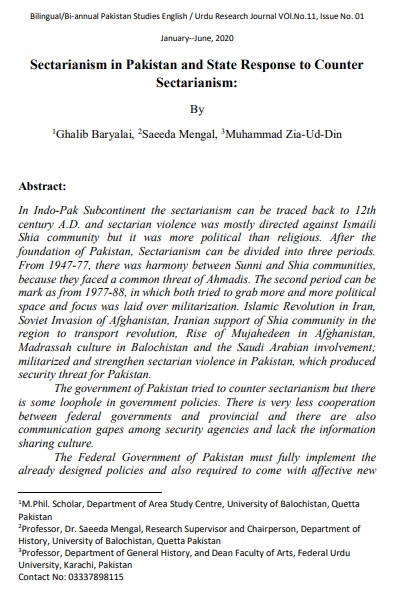Sectarianism in Pakistan and State Response to Counter Sectarianism:
Keywords:
Iran, Saudi Arabia, Pakistan, Terrorism, Sectarianism and Law Enforcement AgenciesAbstract
In Indo-Pak Subcontinent the sectarianism can be traced back to 12th
century A.D. and sectarian violence was mostly directed against Ismaili
Shia community but it was more political than religious. After the
foundation of Pakistan, Sectarianism can be divided into three periods.
From 1947-77, there was harmony between Sunni and Shia communities,
because they faced a common threat of Ahmadis. The second period can be
mark as from 1977-88, in which both tried to grab more and more political
space and focus was laid over militarization. Islamic Revolution in Iran,
Soviet Invasion of Afghanistan, Iranian support of Shia community in the
region to transport revolution, Rise of Mujahedeen in Afghanistan,
Madrassah culture in Balochistan and the Saudi Arabian involvement;
militarized and strengthen sectarian violence in Pakistan, which produced
security threat for Pakistan.
The government of Pakistan tried to counter sectarianism but there
is some loophole in government policies. There is very less cooperation
between federal governments and provincial and there are also
communication gapes among security agencies and lack the information
sharing culture.
The Federal Government of Pakistan must fully implement the
already designed policies and also required to come with affective new policies. The Provincial Government of Balochistan is required to suggest
recommendations for policy making on research and rational basis. The
law enforcement agencies are required to inforce the policy approved by
Provincial and federal government.
References
Anti-Terrorist Act of 1997.
Chubin, S. (2012). Iran and the Arab Spring: Ascendancy Frustrated. GRC
Gulf Papers, 21-27.
el-Nawawy, M., & Elmasry, M. H. (2015). Revolution or crisis? Framing
the 2011 Tahrir Square protests in two Pan-Arab satellite news
networks. Journal of Applied Journalism & Media Studies, 4(2),
-258.
Fahim, K., & Cunningham, E. (2017). “By backing Saudi Arabia’s vision
of the Middle East, Trump may be sowing the seeds of conflict,”
The Washington Post.
Global Peace Index-2019. (2019). Institute for Economics & Peace. New
York.
Khaitous, T. (2009). Arab reactions to a nuclear-armed Iran. Policy Focus,
(7).
Khan, Āmer Ahmad. (February 1995). “Striking at the Roots,” The Herald.
p. 63.
Khan, Zaigham. (December, 1996). “Crime and Punishment,” The Herald.
p.57.
Muasher, M., & Sadjadpour, K. (2011). Christopher Boucek 1973-2011.
Review of Middle East Studies, 293-295.
Nasar, Seyyed Hossein. (1994). Ideals and Realities of Islam. London:
Harper Collins Publishers.
National Counter Terrorism Authority Act-2013.
Pakistan Security Report-2018. (January, 2019). Peace and Conflict Study.
Sectarian Violence in Pakistan. “South Asia Sectarianism petrol”. At
https://www.satp.org/datasheet-terroristattack/fatalities/pakistan- (Retrieved at 23 April, 2019).



